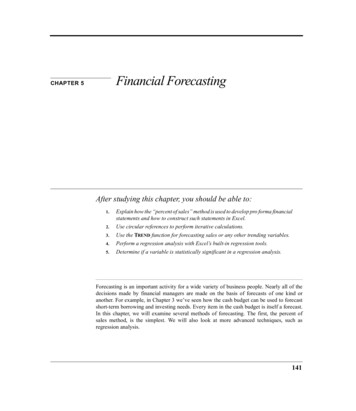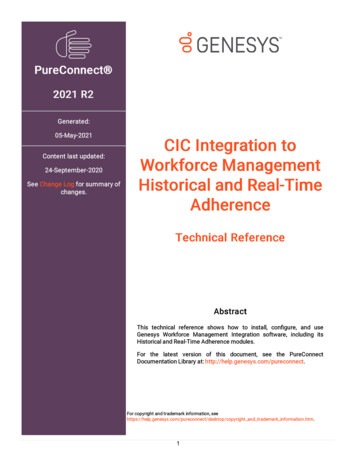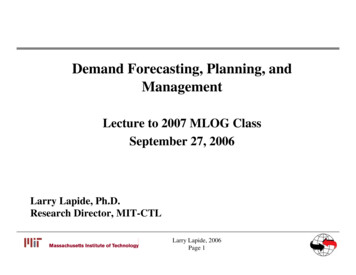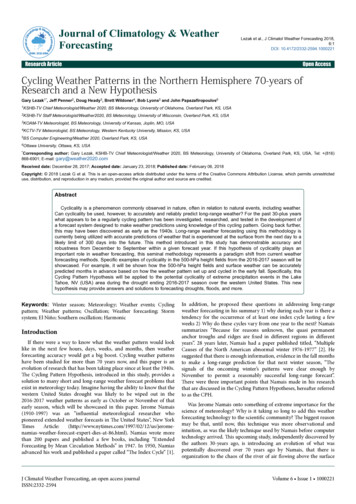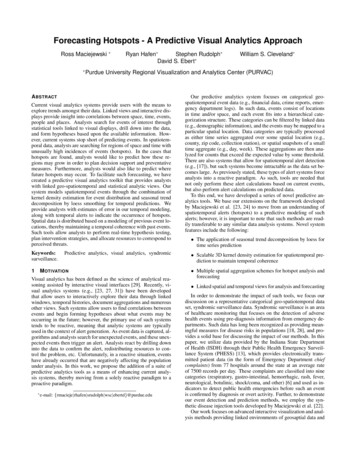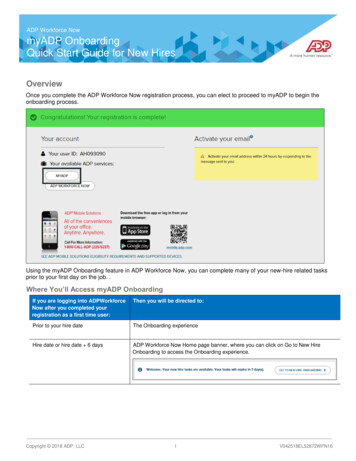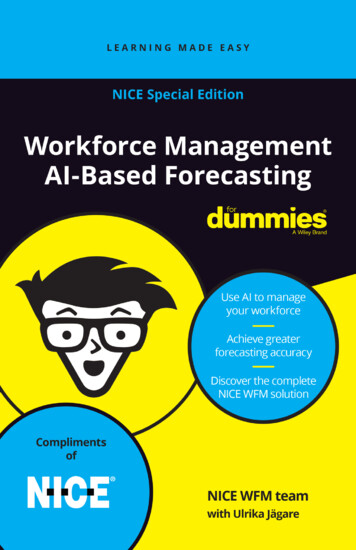
Transcription
These materials are 2020 John Wiley & Sons, Ltd. Any dissemination, distribution, or unauthorized use is strictly prohibited.
WorkforceManagementAI-BasedForecastingNICE Special Editionby NICE WFM teamwith Ulrika JägareThese materials are 2020 John Wiley & Sons, Ltd. Any dissemination, distribution, or unauthorized use is strictly prohibited.
Workforce Management AI-Based Forecasting For Dummies ,NICE Special EditionPublished by: John Wiley & Sons, Ltd., The Atrium, Southern Gate Chichester, West Sussex,www.wiley.com 2020 by John Wiley & Sons, Ltd., Chichester, West SussexRegistered OfficeJohn Wiley & Sons, Ltd., The Atrium, Southern Gate, Chichester, West Sussex, PO19 8SQ,United KingdomAll rights reserved No part of this publication may be reproduced, stored in a retrieval system ortransmitted in any form or by any means, electronic, mechanical, photocopying, recording, scanningor otherwise, except as permitted by the UK Copyright, Designs and Patents Act 1988, without theprior written permission of the Publisher. For information about how to apply for permission to reusethe copyright material in this book, please see our website http://www.wiley.com/go/permissions.Trademarks: Wiley, For Dummies, the Dummies Man logo, The Dummies Way, Dummies.com,Making Everything Easier, and related trade dress are trademarks or registered trademarks ofJohn Wiley & Sons, Inc. and/or its affiliates in the United States and other countries, and may notbe used without written permission. NICE and the NICE logo are registered trademarks ofNICE. All other trademarks are the property of their respective owners. John Wiley & Sons, Ltd.,is not associated with any product or vendor mentioned in this book.LIMIT OF LIABILITY/DISCLAIMER OF WARRANTY: WHILE THE PUBLISHER AND AUTHOR HAVEUSED THEIR BEST EFFORTS IN PREPARING THIS BOOK, THEY MAKE NO REPRESENTATIONS ORWARRANTIES WITH RESPECT TO THE ACCURACY OR COMPLETENESS OF THE CONTENTS OFTHIS BOOK AND SPECIFICALLY DISCLAIM ANY IMPLIED WARRANTIES OF MERCHANTABILITYOR FITNESS FOR A PARTICULAR PURPOSE. IT IS SOLD ON THE UNDERSTANDING THAT THEPUBLISHER IS NOT ENGAGED IN RENDERING PROFESSIONAL SERVICES AND NEITHER THEPUBLISHER NOR THE AUTHOR SHALL BE LIABLE FOR DAMAGES ARISING HEREFROM. IFPROFESSIONAL ADVICE OR OTHER EXPERT ASSISTANCE IS REQUIRED, THE SERVICES OF ACOMPETENT PROFESSIONAL SHOULD BE SOUGHT.For general information on our other products and services, or how to create a custom ForDummies book for your business or organization, please contact our Business DevelopmentDepartment in the U.S. at 877-409-4177, contact info@dummies.biz, or visit www.wiley.com/go/custompub. For information about licensing the For Dummies brand for products or services,contact BrandedRights&Licenses@Wiley.com.ISBN: 978-1-119-61442-5 (pbk); ISBN: 978-1-119-61452-4 (ebk)Printed in Great Britain10 9 8 7 6 5 4 3 2 1Publisher’s AcknowledgmentsSome of the people who helped bring this book to market include thefollowing:Project Editor:Carrie Burchfield-LeightonBusiness DevelopmentRepresentative: Frazer HossackAcquisitions Editor: Katie MohrProduction Editor:Mohammed Zafar AliEditorial Manager: Rev MengleThese materials are 2020 John Wiley & Sons, Ltd. Any dissemination, distribution, or unauthorized use is strictly prohibited.
Table of ContentsINTRODUCTION. 1About This Book. 1Icons Used in This Book. 2Beyond This Book. 2CHAPTER 1:Explaining the Importanceof Forecasting Accuracy. 3Explaining the Basics of Forecasting. 4Capturing data. 5Predicting workload. 6Detailing the forecast. 7Considering other factors. 7Identifying Challenges in WFM. 8Understanding Why Forecasting Accuracy Is So Important. 9Exemplifying Cost Impact of Inaccuracies in the Forecast. 10CHAPTER 2:Detailing a Selected Set ofForecasting Models. 13The Weighted Moving Average Model. 14The Box-Jenkins ARIMA Model. 15Identification. 16Estimation and testing. 19The Exponential Smoothing Model. 20Level. 21Trend. 22Seasonality. 23The Multilinear Seasonal Regression Model. 24CHAPTER 3:Choosing the Right Forecasting Model. 27Comparing Forecasting Model Accuracy. 27Avoiding Limitations in Forecasting Applicability. 29CHAPTER 4:Understanding How AI Makes a Difference. 31Describing the Basics of AI. 31Understanding the Role of AI in WFM. 33Managing labor demands. 33Keeping employees engaged. 33Table of ContentsiiiThese materials are 2020 John Wiley & Sons, Ltd. Any dissemination, distribution, or unauthorized use is strictly prohibited.
Exemplifying How AI and ML Enhance WFM Performance. 34Using intelligent skill assessment. 34Leveraging skills efficiently and intelligently. 35Optimizing closed-loop scheduling. 35Increasing the overall value of forecasting. 35Selecting the Right Forecasting Model. 36Introducing the Best Pick Method. 37CHAPTER 5:Introducing the NICE Solution for WFM. 41Presenting NICE WFM. 41Pinpointing the usefulness of long-term forecasts. 42Introducing predictive hiring. 43Diving into tactical forecasting. 44Explaining the advantage of intelligent scheduling. 44Seeing the benefits of intraday management. 46Explaining Benefits for the Back-Office Function. 48Running Your NICE WFM Solution in the Cloud. 49Showing Examples of NICE AI-Based Forecasting. 51The travel company example. 51The insurance company example. 52CHAPTER 6:ivTen Reasons a WFM AI-BasedSolution Can Help. 55Workforce Management AI-Based Forecasting For Dummies, NICE Special EditionThese materials are 2020 John Wiley & Sons, Ltd. Any dissemination, distribution, or unauthorized use is strictly prohibited.
IntroductionWhen forecasting demand in a contact center, back office,or branch or retail organization, you can draw on anumber of techniques from mathematics and statistics.While today’s forecasting methods are amazing, it’s still not possible to define the perfect forecasting formula that will accountfor all possible scenarios. Instead, the challenge is to have theright expertise and capability at the right time to understandwhich forecasting model will generate the most accurate resultsin any given situation.In today’s society with complex and rapidly changing contexts,these challenges are tackled by predictive forecasting technologies that use data to revolutionize businesses well beyond thecontact center. The key is more accurate projections, and it’senabled by using techniques such as machine learning (ML) andartificial intelligence (AI).Although the concept is simple, the execution is anything but. Thisbook aims to explain as well as exemplify the value of w orkforcemanagement (WFM) AI-based forecasting.About This BookIn this book, you discover the basics of forecasting and find outwhat the most common challenges are in WFM, as well as howto tackle those challenges. You study how forecasting accuracygenerates more value and drives business results up, and you alsogain an understanding about the cost that can be incurred due toinaccurate forecasts.The book walks you through a selected set of forecasting modelsand explains how to assess the value of a model. Furthermore,Workforce Management AI-Based Forecasting For Dummies, NICESpecial Edition, puts forecasting in the context of AI and describeshow, through a number of customer stories, the NICE solution isutilizing these techniques to augment WFM.Introduction1These materials are 2020 John Wiley & Sons, Ltd. Any dissemination, distribution, or unauthorized use is strictly prohibited.
Icons Used in This BookI occasionally use special icons to focus attention on importantitems. Here’s what you’ll find:This icon with the proverbial string around the finger remindsyou about information that’s worth recalling.Expect to find something useful or helpful by way of suggestions,advice, or observations here.Warning icons are meant to get your attention to steer you clear ofpotholes, money pits, and other hazards. Soft clouds can deliverhard knocks.This icon may be taken in one of two ways: Techies will zero inon the juicy and significant details that follow; others will happilyskip ahead to the next paragraph.Beyond This BookThis book can help you generate more value out of your forecasts in WFM. If you want more deep dives into resources beyondwhat’s offered in this book, additional reading that’s chock-fullof useful info can be found at the following links:»» www.nice.com/wfm: All about the NICE solution»» ce-management: NICE’s intelligent WFM solutionssuite»» www.nice.com/WFMVideoHub/index.html: A video serieswhere experts in WFM and employee engagement discusshow you can efficiently empower and engage your teams2Workforce Management AI-Based Forecasting For Dummies, NICE Special EditionThese materials are 2020 John Wiley & Sons, Ltd. Any dissemination, distribution, or unauthorized use is strictly prohibited.
IN THIS CHAPTER»» Sorting out the fundamentals offorecasting»» Describing common obstacles in workforce management»» Explaining why accuracy is key inforecasting»» Detailing how forecast inaccuraciesimpacts the company cost structureChapter1Explaining theImportance ofForecasting AccuracyTraditionally contact centers have been called call centers. Thename contact center reflects that call centers have evolvedover the years to handle more than just phone calls. Somecompanies even adjust their organizational settings to this andset up separate departments to handle different types of communication mediums, such as inbound and outbound calls, emails,chats, SMS, and social media.A contact center can also be internal or external. Small companies usually develop their own capabilities internally, while largercompanies tend to outsource their contact center functions orspin off these functions to a separate company.Today’s contact center stands face to face with increasingchallenges: new contact channels, complex skill set requirements, and elevated customer expectations. Traffic rises andfalls, customer preferences shift, and new technologies disruptday-to-day life. Amid all this change, you demand increasinglyCHAPTER 1 Explaining the Importance of Forecasting Accuracy3These materials are 2020 John Wiley & Sons, Ltd. Any dissemination, distribution, or unauthorized use is strictly prohibited.
higher performance from your employees, and they may expectmore from your company.To manage this in a successful way, you need to get proper workforce management (WFM) in place. WFM refers to an integratedset of processes that a company uses to secure the right numberof people, with the right skills, at the right time. WFM involvesaccurately forecasting labor requirements and creating and managing staff schedules to meet the demand at the interval level,daily or hourly.WFM systems help organizations gain insights into businessrequirements, such as the exact number of employees needed tohandle a number of interactions at a given time of the day, week,or month. For example, in a contact center, you need to handle theexpected volume of interactions on a detailed level. WFM helpsmaximize the use of labor by forecasting the volume of transactions like calls, messages, or emails as well as scheduling thecorrect number of agents with the proper skills based on previousperformance.In forecasting, the main objective is to produce an accurate forecast of your interaction volume and then determine the number ofstaff required. The solution then optimizes and schedules weeksor months in advance — a forecast that you can truly rely on forstaffing and hiring. However, in order to achieve that type of reliability, you must be ready to work on your forecasting accuracy.What this means and how to do that efficiently are some of theinteresting parts addressed in this chapter.Explaining the Basics of ForecastingThe basis of any good staffing plan is an accurate workload forecast. Without a precise forecast of the work to be expected, theeffort to calculate staff numbers and create detailed schedulescould be wasted. The old saying “garbage in, garbage out” isespecially true when applied to contact center workforce management. A precise and accurate forecast is a vital beginning stepin the process.As you might understand, the purpose of the forecast is to predict workload so you can get the right number of staff in place tohandle it. The most common scenario for forecasting is normal,4Workforce Management AI-Based Forecasting For Dummies, NICE Special EditionThese materials are 2020 John Wiley & Sons, Ltd. Any dissemination, distribution, or unauthorized use is strictly prohibited.
day-to-day operations. But given the need for skills-based routing to handle calls with properly skilled agents, the forecastsneed to be built at the skill or contact type level as well as the dailyand interval level in order to properly meet the need. This useof skills greatly complicates the forecast and scheduling processbecause agents normally have multiple skillsets and handle different types of interactions, as well.You may also require a forecast for special situations, such asplanning for new call type(s), opening a new center, a companymerger or acquisition, or a change in operating hours. Anotherscenario could be that you may be implementing a new technology that will affect your call volume or support pattern and needto determine what the resulting change means to staff workload.Whatever the reason, you need to understand the basic principlesbehind workload forecasting and how to apply them to accurately plan your resources. The steps involved are described inthis section.Capturing dataBecause the assumption is that history is the best predictor of thefuture, gathering data that represents the history of what you areaiming to predict is the first task. An example of data source in thecontext of a call center could therefore be historical daily reportsand data feeds with the number of calls offered and the call duration, usually referred to as average handling time, divided intonumber of half hours.The number of calls offered should correspond to the workload forwhich you need to staff in the call center example. This assumption is valid as long as all calls are getting in and that none areblocked due to insufficient capacity. Remember to validate thisassumption by requesting data on particularly busy periods fromyour telco carriers.The traditional probability distribution function used for predicting the required staffing to meet the specific service levels of theforecasted demand is Erlang C, and it doesn’t take abandonedcalls into consideration. Erlang C is also not designed to handlemulti-skill complexity or deferred work.CHAPTER 1 Explaining the Importance of Forecasting Accuracy5These materials are 2020 John Wiley & Sons, Ltd. Any dissemination, distribution, or unauthorized use is strictly prohibited.
When capturing your historical data, collect at least two years ofdata if it’s available and has enough quality. Less than two yearsmay be sufficient depending on the algorithm you intend to useit for but usually won’t give you the most accurate tracking oftrends and monthly/seasonal patterns that you would get from atleast 24 months of historical data.When it comes to data quality, it’s absolutely critical that youanalyze the data properly to make sure there are no data irregularities. You should look for any abnormally low or high numbers, so called outliers, as well as missing data. When you identifysomething out of the ordinary, first determine the reason for theanomaly and then decide if it needs to be adjusted or removed.The key in dealing with data abnormalities is to first determinethe reason it occurred. Then, if it’s a one-time incident, or anevent that might occur again but you can’t predict when it willhappen (like a storm), you want to cleanse the data and normalizethe numbers up or down to reflect realistic volumes. On the otherhand, if it’s a repeatable, predictable event, these numbers needto stay in the data, so the forecast reflects the event in the future.Predicting workloadTime to predict how the workload will look in the coming months.Various methodologies can get you to this future forecast, butthere are three basic types:»» Time series: This approach focuses on pattern recognitionand pattern changes and relies solely on historical data. Callvolume is influenced by a variety of factors over time, andeach of the factors can be isolated and used to predict thefuture. The time-series method performs best when trendsor cycles are evident and stable.»» Causal methods: Causal methods rely on establishedcause-and-effect relationships between the data to beforecasted and other factors that might influence the dataand hence the forecast. These activities can affect thereliability and accuracy of a forecast and how it is distributedacross a day, week, or month.»» Qualitative methods: Qualitative methods are used whendata is scarce. These methods use judgment to turnqualitative insights into quantitative estimates.6Workforce Management AI-Based Forecasting For Dummies, NICE Special EditionThese materials are 2020 John Wiley & Sons, Ltd. Any dissemination, distribution, or unauthorized use is strictly prohibited.
Detailing the forecastDetailing the forecast involves breaking down the monthly forecast into a daily prediction, then further down into an hourlyor half-hourly predictions. To predict daily workload, you mustfirst calculate day-of-week factors. For example, in a call center,Mondays are usually busier than other days of the week, and it’simportant to know what percentage of the week’s workload Mondays and others represent.The good news is that it’s not necessary to go back and analyzetwo years’ worth of data to determine these specific factors. Typically evaluating the last few weeks’ worth of daily call volume datais enough to identify daily patterns. Select several representativeweeks of data, meaning those without holidays or other majorevents that might skew the proportions. Then you can see whatthe total Monday volume is compared to the weekly total. Repeatthe procedure for the other days of the week. These percentagesreflect your day-of-week patterns.After the daily forecast is in place, repeat the process for timeof-day patterns. If calls came in evenly throughout the day,scheduling would be easy, but because that’s not reality, you needto know when the peaks, valleys, and average times are.Keep in mind that the detailed workload forecast in a call centerexample should include not only call volume predictions but alsoa prediction about average handling time.Using a WFM solution for automating the process of detailing theforecast is highly recommended. However, although automationimproves forecast speed and potentially also your forecast accuracy, you still need to think through your forecast and make sureto set the right contextual parameters.Considering other factorsOther potential factors that could fall outside of the historical dataand impact your forecast could be things such as the following:»» A new format is suddenly introduced by the billingdepartment.»» A new process for packaging and shipping is launched withlittle or no forewarning.CHAPTER 1 Explaining the Importance of Forecasting Accuracy7These materials are 2020 John Wiley & Sons, Ltd. Any dissemination, distribution, or unauthorized use is strictly prohibited.
»» Marketing launches a new promotion campaign withouttelling the contact center.»» The sales department comes out with a new sales forecast.Communicate regularly with all these influencers on the workloadas you prepare and fine-tune your forecast.Identifying Challenges in WFMWhile forecasting in the context of WFM refers to forecastinglabor requirements and creating and managing staff schedules,budgeting in WFM is knowing how much staff a company canafford to have on hand. WFM allows companies to use calculatedforecasts to optimize staff deployment and balance workload aslabor demands change. This process is typically referred to as Service Level Objectives and is measured as handling a certain numberof calls within a certain time frame — for example, 80 percent ofthe calls are handled within 20 seconds.In any organization that has multiple departments with multipleemployees, a certain amount of difficulty and complexity willexist in managing these employees.As part of your forecasting efforts, consider the following WFMchallenges and possible mitigations:»» Time tracking: The main issue in time tracking results frompaper-based time and attendance tracking, with employeesmanually signing in and out. This process is time consumingand costly and open to inaccuracies and potential dishonestyfrom employees.This is many times the case in a back-office environment in acontact center, where it’s often not possible to get details oninteraction volume and handle time per transaction.Capturing that requires a technology solution to monitordesktop activity automatically.»» Scheduling: Any company can have different schedulingparadigms that require employees to be scheduled fordifferent parts of the day. Staff levels can also depend onprojected demand during busy or quiet periods.8Workforce Management AI-Based Forecasting For Dummies, NICE Special EditionThese materials are 2020 John Wiley & Sons, Ltd. Any dissemination, distribution, or unauthorized use is strictly prohibited.
To manage this, applications are now available that help withthings such as automatic employee and pattern assignmentbased on preferences and multiple optimization controls.See Chapter 4 for more information.»» Managing employee absence (or managing exceptions):Planned and unplanned absences or exceptions can strainthe business. Unplanned absences generate extra costs ofcovering the absences and the losses incurred while theabsent employees are being replaced. Planned absences aresimpler to deal with but could still present obstacles.By utilizing adherence and occupancy standards in theindustry, you prepare for, and minimize the impact of, thesesituations.»» Shrinkage: Shrinkage is a reality within the contact centerand refers to the percentage of time for which people arepaid to work, but they aren’t available to handle interactions.Shrinkage can also change during certain intervals — forexample, shrinkage could be higher on Mondays after a longholiday.»» Employee self-service: The request for transparencyaround employee data is difficult to comply with foremployers who don’t have this information stored digitally.»» Holiday tracking: Employees are going to want vacationsduring the summer months when the weather is typicallynicer. You may not be able to accommodate everyone’svacation requests for the same time, and it’s often necessaryto stagger these requests to ensure that the company willstill function.Understanding Why ForecastingAccuracy Is So ImportantAccurate forecasting is critical to successfully managing yourworkforce and meet demand without under-staffing or overstaffing. You need methods that precisely predict how manypeople are needed to run your business. However, predicting thefuture isn’t an easy task.CHAPTER 1 Explaining the Importance of Forecasting Accuracy9These materials are 2020 John Wiley & Sons, Ltd. Any dissemination, distribution, or unauthorized use is strictly prohibited.
WFM presents a few forecasting challenges:»» Constantly changing business needs contradict the usefulness of historical data.»» The demand is driven by external events and not controlledby the company.»» Volume is seasonal dependent and varies greatly.»» Volume patterns change frequently, making projectionsdifficult.Common for all these forecasting challenges is that they all showthe need for using multiple forecasting methods and algorithmsto handle the data.The objective of generating forecasts is for them to be as preciseand unbiased as possible. A forecast bias occurs when consistentdifferences exist between actual outcomes and previously generated forecasts. Forecasts have a general tendency to be too high ortoo low. Forecast accuracy should be used to determine effectiveness, not to punish demand planners.To improve forecast accuracy and trust in the forecast, considerinput and participation from relevant company functions, including Sales, Marketing, Finance, and Senior Management. Also takeinto account statistical input.Measuring the entire process helps you determine which assumptions are more accurate, focusing on the process that led to thefinal demand plan, as well as to the source of any errors. A highlyaccurate forecast will not only generate satisfied customers foryou but also engage your employees and make sure your bottomline stays healthy.Exemplifying Cost Impact ofInaccuracies in the ForecastAchieving the service level targets in operational performance isdirectly related to achieving more accurate staffing. Both overand under-staffing carry unnecessary costs, such as direct laborexpenses and opportunity costs from activities sacrificed becausestaffing wasn’t optimal.10Workforce Management AI-Based Forecasting For Dummies, NICE Special EditionThese materials are 2020 John Wiley & Sons, Ltd. Any dissemination, distribution, or unauthorized use is strictly prohibited.
A major benefit with artificial intelligence (AI)-based forecastingis that it helps users achieve greater cost efficiencies. A compositeanalysis with customer contact types (CTs) estimates that a 4.5percent gain is achievable even under fairly traditional assumptions. While individual results may vary, the consistent trend issizable gains that yield a highly favorable return on investment(ROI).In Figure 1-1, you see an example of potential savings thatassumes the following conditions:»» 7.5 FTE hours»» 24-hour operation»» 80 percent of the calls with an average handling time of20 seconds (a good service level)»» 20 percent shrinkage, where staff was paid to work but notable to take calls (this includes time for training, for example)»» Loaded hourly rate of 15 per hour ( 31,200 annual forsalary, benefits, and onboarding)FIGURE 1-1: Merged CTs between various customers to estimate potentialsavings.A more specific example of how forecast inaccuracies are impacting business results is a customer that’s interested in sharpeningits interval accuracy. This U.S.-based existing customer handleshundreds of thousands of calls annually and needs a solution toaddress the increasing complexity of cases and to improve itsinterval accuracy.CHAPTER 1 Explaining the Importance of Forecasting Accuracy11These materials are 2020 John Wiley & Sons, Ltd. Any dissemination, distribution, or unauthorized use is strictly prohibited.
After making significant improvements in volume, the forecast byinterval resulted in nearly 13 percent more intervals within theiraccuracy goals of /- 10 percent. Getting to interval accuracy iscritical in understanding what staffing levels are required and incontrolling associated costs.It is one thing to measure monthly accuracy of a forecast, but thisnumber can hide real problems of staffing at the interval level.Overstaffing in one interval may average out an understaffing,but at the interval level the company will see wasted salaries andmissed service levels.12Workforce Management AI-Based Forecasting For Dummies, NICE Special EditionThese materials are 2020 John Wiley & Sons, Ltd. Any dissemina
generates more value and drives business results up, and you also gain an understanding about the cost that can be incurred due to inaccurate forecasts. The book walks you through a selected set of forecasting models and explains how to assess the value of a model. Furthermore, Workforce Managemen
